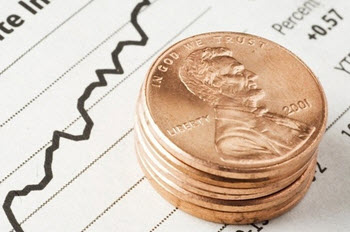 Common shares that trade at low prices are often referred to as penny stocks, especially if they are shares of nano cap or micro cap companies. There is no world-wide agreement about exactly what constitutes a penny stock, but generally speaking, the term penny stock is associated with low market capitalization, as well as a combination of low liquidity, high volatility and large bid-ask spreads. Both exchange traded stocks and OTC-stocks (stocks traded outside exchanges) can be considered penny stocks.
Common shares that trade at low prices are often referred to as penny stocks, especially if they are shares of nano cap or micro cap companies. There is no world-wide agreement about exactly what constitutes a penny stock, but generally speaking, the term penny stock is associated with low market capitalization, as well as a combination of low liquidity, high volatility and large bid-ask spreads. Both exchange traded stocks and OTC-stocks (stocks traded outside exchanges) can be considered penny stocks.
Penny share, cent stock and cent share are all synonyms to penny stocks.
Investors with small bankrolls are often attracted to penny stocks, since penny stocks are cheap to buy and can swing greatly up and down. Even a small investment can yield a significant profit when a stock suddenly goes up 60 points in 72 hours. However, these swings also make penny stocks a risky investment compared to general stock investments. One way of decreasing the estimated overall volatility of an investment portfolio is to balance penny stock investments with blue chip stock investments.
Why is investing in penny stocks so risky?
- Many penny stock companies are newly formed companies. This means that you don’t have a lot of historical data to base your analysis on.
- Many penny stock companies are traded OTC instead of being listed on a stock exchange because they would fail to live up to the minimum requirements imposed by the stock exchange.
- Low liquidity means that you might not be able to sell your penny stocks when you want to sell them, at least not without accepting a low-ball price. Don’t invest money that you might need to turn back into cash in a hurry.
- Due to the low liquidity, a sell off can cause a major drop in share price even if the company is doing great. Low liquidity also means that it can take quite a lot of time for the share price to recuperate.
- Penny stocks tend to attract day traders rather than (long term) investors and this contributes to the volatility.
- Stock market manipulators are fond of penny stocks. They can purchase a lot of shares without risking a lot of money, and the comparatively low share price makes it easier to lure in inexperienced investors when they commence their pump-and-dump scheme.
A common misconception among inexperienced investors is that all stock start out as penny stock, i.e. is penny stock when the stock first enters the stock market. This is an appealing thought, since it promotes that idea that you can find the next Microsoft or the next Wal-Mart among today’s cheap penny stock and just hold o n to it to make a fortune. Even though this is of course theoretically possible, many of today’s high priced stocks have never been penny stocks. Both Microsoft and Wal-Mart traded for well over $20/share on their very first day of trading. What fools many novice investors is the adjusted stock price of a share. If you look at the adjusted stock price for Microsoft for its very first day of trading, you will see a price of $0.09. Nine cents a share, this must be penny stock, right? But the adjusted stock price takes later splits into account. It was definitely not possible to buy a share in Microsoft for 9 cents on the stock exchange when Microsoft first went public.
This article was last updated on: March 17, 2023